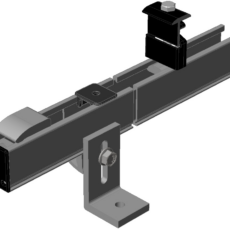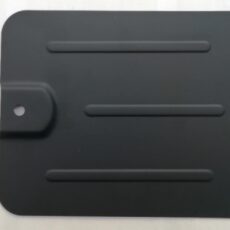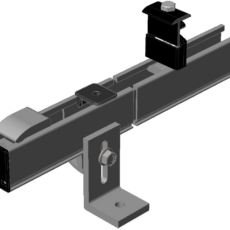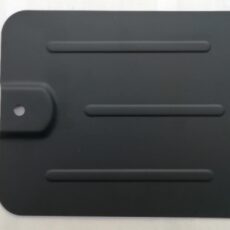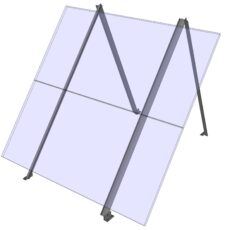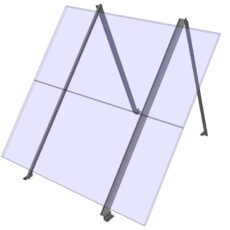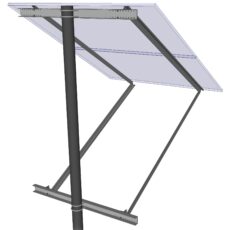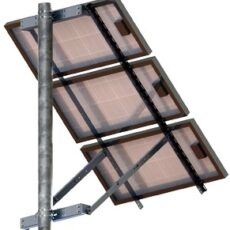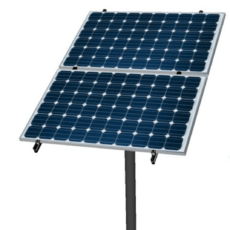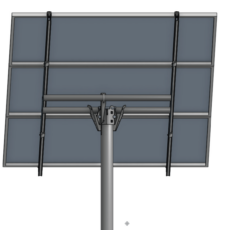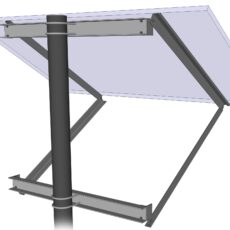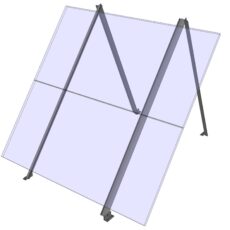Selecting the proper mount for your solar panels is important. The solar modules must be outdoors in open, direct sunshine facing the noon sun direction. (Yes, we have seen panels installed in the shade!) Exposure to sunshine must be free of all shadows from trees, 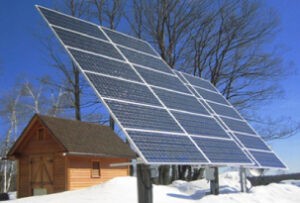 wires, buildings, etc. A shadow on any part of a photovoltaic module will cut off much of its power (no matter what some advertisements claim).
wires, buildings, etc. A shadow on any part of a photovoltaic module will cut off much of its power (no matter what some advertisements claim).
Precise aim is not necessary. 95% of full power is produced within 20 degrees of the sun. As the sun rises and sets, modules aimed at the noon sun give full power from 10 a.m. to 2 p.m. Morning sun and late afternoon sun is less direct so less power is generated during these time periods. This means on a full sunny day, on average across the country, you can count on about 5 hours at a module’s rated amperes.
Tilting to face the noon sun’s elevation twice a year, spring and fall, produces more charging than fixed mounts. To shed snow, set winter tilt near vertical facing south. For fixed mounts, splitting the difference between summer and winter tilt angles will give the best average solar production from the modules.
As the solar industry has grown and changed, additional concerns surrounding the proper mounting of solar modules, especially in roof mount applications, have risen. Roof mounted solar arrays are the most common and many roofing companies have expressed concerns regarding how weatherproofing of installations is being handled. Maintaining the integrity of the roof, protecting all penetrations with proper sealants and flashing, and making sure that the roof itself is built to handle the load will assure the homeowner that the roof will not leak and will last the lifetime of the array. Some of the roof mounts we sell come with their own flashing and sealants. We highly recommend that if the modules will be mounted to a roof that has a warranty put in place by the roofing company, check to make sure the warranty will not be voided if modules are attached. Always use materials that will properly seal the roof penetrations and protect against leaks.
Types of Solar Mounts
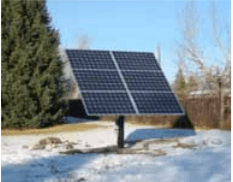
Pole Mounts
Pole mounts in the yard are easy to set up and adjust seasonally. They must be located where there will be no shadows from trees or buildings, even in winter. They more easily pass code than mounts attached to a building. Limit to 6 or 8 larger modules per each mount is safest in high winds. Check before ordering and setting posts in the ground. Many manufacturers have different options available for the amount of modules that you want to place on each post. Typically the larger the array, the larger the post size and footing that needs to be poured.
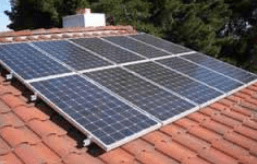
Roof Top Mounts
Roof top or south wall mounts can place modules high enough to avoid tree shadows. Chances of theft are less. Seasonal adjustment may be more difficult, and the electrical code may require a ground fault interrupter when installed on a dwelling. Roof mounts come with many different attachment options depending on the roofing material. For composite roofs, a standard flashed L-foot and rails is most common. Most recently, rail-less options have become popular. We carry both. For standing seam or metal roofs, many times you can get away with non-penetrating seam clamps. For corrugated roofs, roof blocks with a lag bolt are available.
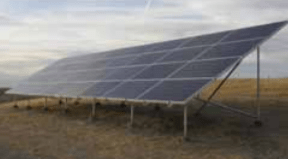
Ground, Roof & Awning Mounts
Fixed Ground Mounts are usually larger arrays that cannot be seasonally tilted. We can help custom design large ground mount arrays. If the property is clear of shading and roof space is lacking room for a larger array, a ground mount might be the right direction to go. Some inspectors may require a fence to encompass the installation to protect people and animals from coming in contact with high voltage wiring. Adjustable Ground Mounts typical hold a smaller quantity of module per column, but are seasonally adjustable. These options can also be used in roof and awning mount configurations.
RV Mounts
R.V. mounts attach modules to the roof individually, or S-RV RAILS hold 2 to 4 modules on a single rack attached to the roof only at the 4 points. Usually tilting is not necessary if you’re following the sunny weather, but the full set of S-RAILS allows tilt-up on an RV.
Custom Design Service & Support
Backwoods Solar offers FREE custom design service for your alternative energy system as well as FREE after-sale technical support for the life of the system – it’s what has helped make us America’s most trusted off-grid power supplier. Let us work for you! Contact us online or call us 208-263-4290 to get started.


